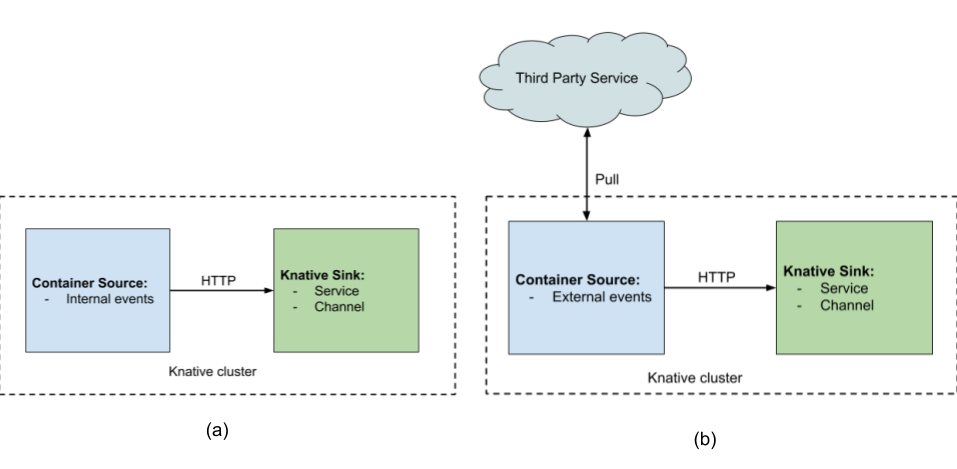Container Sources as mentioned in the official documentation:
... instantiate a container image which can generate events until the ContainerSource is deleted. This may be used (for example) to poll an FTP server for new files or generate events at a set time interval.
These types of event sources are described in so-called ContainerSource object manifest (e.g manifest.yaml) and can be deployed to your Knative cluster with the single command kubectl apply -f manifest.yaml.
This repository contains a collection of Container sources for knative eventing. They are meant to be an introduction to writing event sources.
In this repository will use the term Container Source to describe a Knative event source of the kind ContainerSource.
A container source generates events and forwards those events to an event receiver called a sink.
There are two types of container sources depicted in the diagram below.
a) Container sources that generate events in an autonomous manner (e.g Task that runs at a regular interval)
b) Container sources that pull events from a third-party event provider (e.g Google PubSub, Weather service)
Event sources that need a publicy accessible endpoint (i.e WebHook) tend to be written using a Kubernetes controller (see this tutorial)
A sink receives the events sent by the container source. In the context of Function as a Service, you can think of a sink as a function, but it could be something else.
Container Sources are custom Kubernetes objects. A well configured Knative cluster will have the ContainerSource Custom Resource Definition pre-defined and you will be able to create custom objects of the Kind ContainerSource.
A sample manifest is shown below. Like most Kubernetes objects it has an apiVersion, a kind, some metadata with a mandatory name and a spec. The specification of a Container Source is fully described in the API but in its simplest form contains a container image (which once running will generate or pull the events) and a sink which is the event receiver.
apiVersion: sources.eventing.knative.dev/v1alpha1
kind: ContainerSource
metadata:
name: bashsample
spec:
image: gcr.io/triggermesh/bash
sink:
apiVersion: eventing.knative.dev/v1alpha1
kind: Channel
name: defaultThe specification is still v1alpha1 and may change. In addition to the image name and the sink, you can also define a set of environment variables, some arguments to the container and a service account name.
To generate event you will write code in the language of your choice. The events will then be sent over HTTP to the URL of the sink
The URL of the sink can be obtained as an environment variable, therefore a short example of an event generation bash script event.sh could be:
#!/bin/bash
set -ex
while true; do
curl -XPOST -H 'Content-type: application/cloudevents+json' -d '{"Hello":"World"}' ${SINK}
sleep 60
doneThe code generating events needs to be containerized so it can be referenced by a Docker image in the Container Source manifest.
A short Dockerfile for the previous script would be:
FROM debian:7-slim
RUN apt-get update && \
apt-get install -y curl
ADD event.sh /event.sh
ENTRYPOINT ["/event.sh"]
The Knative event controller which handles Container Sources handles the destination for events using the sink object referenced in the manifest. This sink is automatically discovered and referenced as an argument to the container and as an environment variable.
This leads to two technical details
- Use ENTRYPOINT and not CMD in your Dockerfile, otherwise the
--sinkwill be parsed as an executable and not an argument - You can use the environment variable SINK which gives you the address of the sink defined in the manifest
Use the message-dumper as an event receiver. This is a knative service which dumps the incoming events to stdout.
You can create it with:
kubectl apply -f https://github.com/knative/eventing-sources/releases/download/v0.3.0/message-dumper.yaml
The Cloud Native Computing Foundation CNCF through its serverless working group has developed a specification for Cloud Events.
The previous sample how-to showed an event as a pure JSON object, sources in this repository also show how to format a CloudEvent and use this specification to send events from the Container source to the sink.
Each directory showcases the use of a different language as well as different ways to send events.
Each directory contains a Dockerfile to build the event source container image
Each directory contains a manifest.yaml manifest to deploy the event source
We would love your feedback on this tool so don't hesitate to let us know what is wrong and how we could improve it, just file an issue
This plugin is by no means part of CNCF but we abide by its code of conduct
